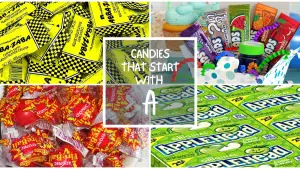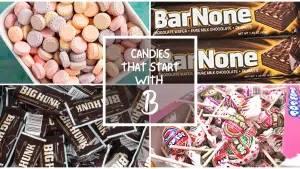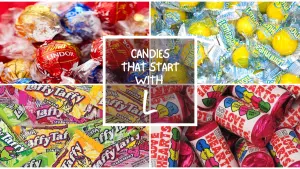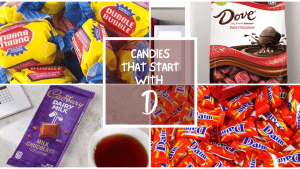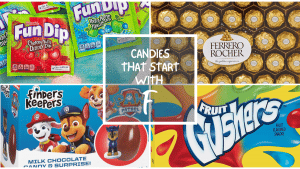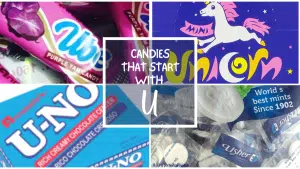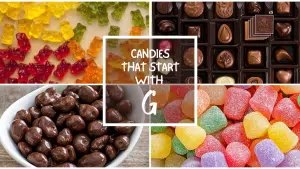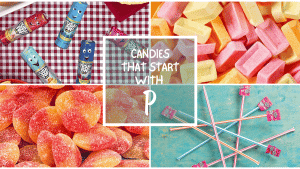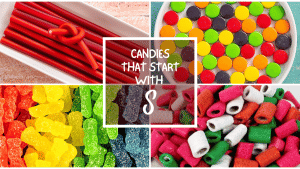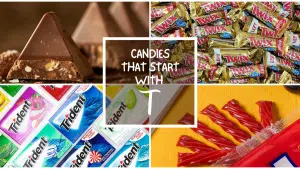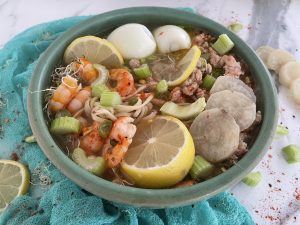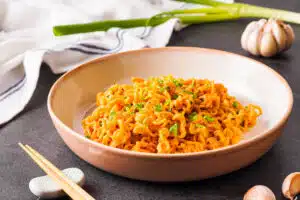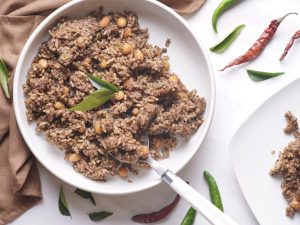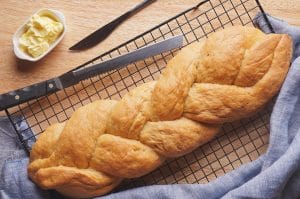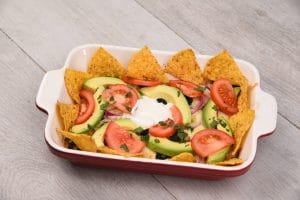All The Candies That Start With C
Important Note: When you buy through our links, we may earn a commission. As an Amazon Associate we earn from qualifying purchases. Content, pricing, offers and availability are subject to change at any time - more info.
If you’re looking for the best seasonal or holiday candies, you’ll find many of your favorites on this list of candy that start with C. From Easter mainstays to Halloween classics, the C candies have it all. Rich chocolate delights to chewy jelly candies and all things caramel to spectacularly crunchy tidbits. Buckle in for your ride on the C candy caboose.
- Cadbury Creme Eggs
- Candy Corn
- Caramel Cream
- Caramello
- Charleston Chew
- Cherry Mash
- Cherry Sours
- Chuckles
- Circus Peanuts
- Clark Bar
- Corn Nuts
- Crunch
- The Final Letter
Cadbury Creme Eggs
Cadbury Creme Eggs are distributed by the Hershey Company and were first introduced in the US in 1963, though they originated in the UK. A favorite springtime or Easter basket treat, Creme Eggs are milk chocolate eggs filled with a sweet and gooey white cream fondant. Though they’re really popular around Easter, Creme Eggs are actually available all year long. Wrapped in a purple foil wrapper with yellow lettering, Creme Eggs come in standard and mini sizes.
Cadbury Creme Eggs are delicious though a little messy. With each bite into the milk chocolate egg, a white and yellow fondant oozes out just like a runny, soft-boiled egg. In addition to the standard flavor, Cadbury Creme Eggs come in other varieties like chocolate and caramel. Lastly, each of these sweet Creme Eggs contains 177 calories, six grams of fat, 26 grams of sugar, three grams of protein, and less than a gram of dietary fiber.
Candy Corn
Invented in the 1880s in Philadelphia, Pennsylvania, Candy Corn was first manufactured by Wunderle Candy Company. Today, however, Candy Corn is most popularly distributed by Brach’s though Jelly Belly is a close runner-up. Candy Corn is most commonly associated with Halloween and the fall season because of the original variety’s autumnal colors of orange, yellow, and white. Now, however, Candy Corn comes in a vast array of colors and flavors. Some quirky seasonal flavors included caramel apple, turkey dinner (yes, they taste like components of a turkey dinner), and fruit to name a few.
Brach’s Classic Candy Corn variety are bite-sized, triangle-shaped candies that have sweet notes of honey in each bite. Candy Corn is primarily composed of sugar, corn syrup, honey, and confectioner’s glaze among artificial flavors. Moreover, they are produced in a plant with milk, eggs, soy, and nuts. Finally, each 15-piece serving of Candy Corn has 110 calories and 22 grams of sugar though they’re not a significant source of fat, protein, or dietary fiber.
Caramel Cream
First introduced by the Goetze’s Candy Company, Caramel Creams came out in the 1920s in Baltimore Maryland. Caramel Creams are individually wrapped, bite-sized candies that are also called “Bullseyes” for their white center. Caramel Creams are chewy caramels with a white cream filling that looks like a bullseye against the brown outer caramel. Although the original flavor is the most popular, Caramel Creams are also available in brownie, Oreo, strawberry smoothie, and caramel apple editions too.
Of note, Caramel Creams are primarily made of corn syrup, sugar, coconut oil, and cornstarch. They are packaged in clear and red cellophane twits and each serving of about three pieces contains 140 calories, three-and-a-half grams of fat, 13 grams of sugar, one gram of protein, and zero dietary fiber. If dietary restrictions are a concern, know that Caramel Creams are neither gluten-free, kosher, nor organic.
Caramello
Caramellos were first introduced in 1968 by both the Canadian and British Cadbury companies. Today, Caramello candy bars are manufactured in the US by Hershey. Essentially, a Caramello is a milk chocolate candy bar filled with a gooey caramel filling. Sweet and rich, Caramellos are delicious and easy to spot by their purple foil wrapper.
Caramellos come in other flavor varieties including dark chocolate, maple, chocolate, and cappuccino; they also come in mini and king-size counterparts to the original candy bar. Some of the predominant ingredients in a Caramello bar include milk chocolate, corn syrup, sugar, and milk; they may also contain soy. Each standard-size Caramello bar has 210 calories, nine grams of fat, 25 grams of sugar, three grams of protein, and one gram of dietary fiber.
Charleston Chew
Invented in 1922 by the Fox Cross Candy Company, Charleston Chews are originally from Boston, Massachusetts. In 1993, however, Charleston Chew was purchased by Tootsie Roll Industries where it remains a mainstay. Available in full-size candy bars as well as a mini-chew variety, the original Charleston Chews are a chocolate-covered, vanilla nougat candy bar. Though the original flavor is most popular, Charleston Chews are also available in strawberry and chocolate nougat varieties.
Charleston Chews are sticky and chewy and finger-licking good. An interesting tidbit is that Charleston Chews were named for the Charleston dance which was popular in the twenties when the candy first came out. The chief ingredients in a Charleston Chew are corn syrup, sugar, milk, and cocoa; each standard-size candy bar contains 80 calories, two grams of fat, and 11 grams of sugar though they’re not a significant source of protein or dietary fiber.
Cherry Mash
This unique confection came out in 1918 in St. Joseph, Missouri and it’s certainly withstood the test of time. Today, Cherry Mash continues to be manufactured by Chase Candy, the same maker who introduced it more than a hundred years ago. Cherry Mash is a small chocolate candy that’s edible in one or two bites depending on how excited you are to eat it all. The milk chocolate coating covers a nougat mixture, or mash, of maraschino cherries and chopped peanuts; this delightful combination is both sweet and salty.
Cherry Mash is unique and not overtly popular so it’s not readily available at your local candy store. Though some specialty shops do carry Cherry Mash in stories, it’s far easier to order it online. It’s worth noting that the primary ingredients in Cherry Mash include sugar, corn syrup, cocoa, peanuts, and cherries; each serving has 285 calories, 13 grams of fat, 25 grams of sugar, four grams of protein, and one gram of dietary fiber.
Cherry Sours
Invented in Texas in 1899, Cherry Sours were originally distributed by the Sathers Candy Company which is now owned by Ferrara Candy Company. Notably, Cherry Sours are similar to jelly beans in shape and size, however, the flavor is much more potent. Cherry Sours are mini red candies that are chewy and subtly sweet though overtly sour. Though they’re not a popular candy store product, Cherry Sours can still be purchased online today. They’re also the perfect addition to a red-themed candy bar.
Cherry Sours are made of sugar, corn syrup, and artificial flavors; if you have dietary restrictions, beware that Cherry Sours are processed in a plant that uses milk, eggs, coconut, soy, and nuts. Lastly, Cherry Sours, which include 10 pieces per serving, have 100 calories and 20 grams of sugar but they’re not a source of dietary fiber, fat, or protein.
Chuckles
First manufactured in 1921 in Chicago, Chuckles are now distributed by the Ferrara Candy Company which is also based in Chicago, Illinois. Chuckles are a jelly candy akin to gum drops. These sticky, chewy confections are coated in sugar sprinkles for an extra hint of sweetness. Original Chuckles come five to a pack with one two-bite hunk of each of the brand’s five flavors: cherry, lemon, lime, orange, and licorice. Besides this original blend of flavors and sizes, chuckles are now available in mini, bite-size bags.
The primary ingredients in Chuckles are corn syrup, sugar, corn starch, and artificial flavors. Unfortunately, though they’re delicious, if you have dietary restrictions, Chuckles are a nightmare; they’re processed in a plant with milk, eggs, nuts, and soy, however, they’re both kosher and gluten-free. Finally, a single serving of Chuckles has 180 calories and 36 grams of sugar but they’re not a source of protein, fat, or dietary fiber.
Circus Peanuts
Manufactured by the Spangler Candy Company since 1941, Circus Peanuts are a unique treat that takes some getting used to. Circus Peanuts are a fat-free, marshmallow candy in the shape and color of, you guessed it, a peanut. The color, however, misses the mark a bit and is more flesh toned than peanut-colored. What’s more, the marshmallow is actually banana-flavored so every bite is a counter-intuitive experience. Nevertheless, they’ve got a cult following and are still produced today.
Though the banana flavor is the original variety of Circus Peanuts, they’re also available in vanilla, lemon, and cherry varieties too. A fun, historical tidbit about Circus Peanuts is that a liquid version of their recipe was used as a coffee sweetener during World War II. Nevertheless, Circus Peanuts are made from sugar, water, pectic, and corn syrup as well as artificial flavors. Ultimately, a serving of Circus Peanuts, which is about four pieces, contains 120 calories and 27 grams of sugar, however, they’re not a noteworthy source of fat, dietary fiber, or protein.
Clark Bar
Introduced in 1917, Clark Bar was invented by a man named David L. Clark for whom it was named. Popularized during the World Wars, the Clark Bar is a chocolate treat that was manufactured in Pittsburgh, Pennsylvania until the mid-50s when it was sold to the Boyer Candy Company, also in Pennsylvania, in 2018. Clark Bars are packaged in a red wrapper with blue writing, making them really stand out in a crowd of candy bars.
Clark Bars have a crispy peanut butter and toffee center and are coated in a milk-chocolate covering. Clark Bars are similar in taste and appearance to a Butterfinger though the Clark Bar is candy-laced with toffee, unlike the Butterfinger. Of note, Clark Bars are made with ingredients such as cocoa, sugar, corn syrup, peanuts, and molasses; other common allergens, besides peanuts, in Clark Bars include milk and soy. Finally, Clark Bars contain 260 calories, 10 grams of fat, 32 grams of sugar, three grams of protein, and one gram of dietary fiber.
Corn Nuts
Developed in 1936 in Oakland, California, Corn Nuts are still a popular candy aisle confection today. Once manufactured by a company called Holloway’s, Corn Nuts are now made by Hormel Foods. Corn Nuts are a funny little treat; essentially, Corn Nuts are real corn kernels that are toasted and seasoned to perfection. The sweet corn niblets coupled with their savory flavorings, make Corn Nuts an irresistible treat.
Besides real corn kernels, Corn Nuts are also made with corn oil, corn syrup, salt, sugar, and a secret blend of perfectly curated seasonings. In addition to the original Corn Nuts blend, they’re also available in varieties such as jalapeno, BBQ, chile, and ranch. Lastly, this crunchy snack has 36 calories, four grams of fat, and two-and-a-half grams of both dietary fiber and protein. Despite being categorized as candy, Corn Nuts contain zero sugar.
Crunch
Invented in Fulton, New York, in the late 30s, the Crunch bar is a classic chocolate candy bar that was long-produced by Nestle. However, in 2018, Nestle sold the rights to the Crunch bar to the Ferrara Candy Company. The original Crunch bar is a milk chocolate treat filled with light and crunchy crispies. Though the milk chocolate variety is surely the most popular, other varieties include Buncha Crunch which are small morsels of chocolate-covered crunchies, peanut butter creme, and caramel & coconut, among others.
In addition to the different flavor profiles, Crunches also come in both standard and fun sizes, the latter of which is a Halloween and goody bag favorite. The primary ingredients in a Crunch bar are milk chocolate and crisped rice. Furthermore, common food allergens in a Crunch Bar may include milk, soy, peanuts, and wheat. In conclusion, Crunch bars contain 230 calories, 12 grams of fat, 24 grams of sugar, and two grams of protein, though they’re not a noteworthy source of dietary fiber.
The Final Letter
From sweet to salt, chewy to hard, and crunchy to uncommon, the C list of candy is certainly a cause for cheer. Whether reminiscing about your candy days of yore or contemplating tasty confections to include on a candy bar or in birthday treat bags, there is a sweet treat for every taste on this list. Which will you try first?

